The Norwich school of painters was the first provincial art movement established in Britain, active in the early 19th century. Artists of the school were inspired by the natural environment of the Norfolk landscape and owed some influence to the work of landscape painters of the Dutch Golden Age such as Hobbema and Ruisdael.
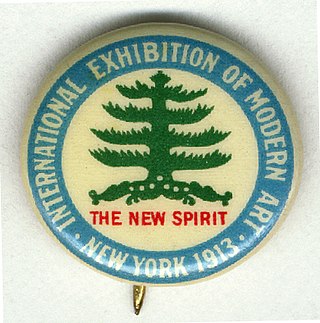
The 1913 Armory Show, also known as the International Exhibition of Modern Art, was organized by the Association of American Painters and Sculptors. It was the first large exhibition of modern art in America, as well as one of the many exhibitions that have been held in the vast spaces of U.S. National Guard armories.
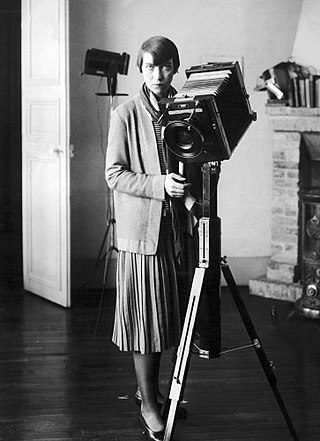
Berenice Alice Abbott was an American photographer best known for her portraits of cultural figures of the interwar period, New York City photographs of architecture and urban design of the 1930s, and science interpretation of the 1940s to the 1960s.
Events from the year 1991 in art.
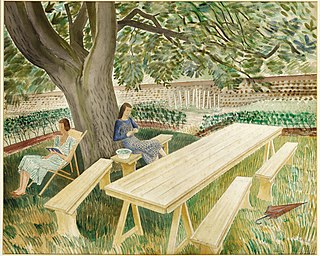
Eric William Ravilious was a British painter, designer, book illustrator and wood-engraver. He grew up in Sussex, and is particularly known for his watercolours of the South Downs, Castle Hedingham and other English landscapes, which examine English landscape and vernacular art with an off-kilter, modernist sensibility and clarity. He served as a war artist, and was the first British war artist to die on active service in World War II when the aircraft he was in was lost off Iceland.
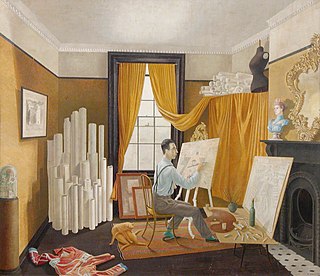
Edward Bawden, was an English painter, illustrator and graphic artist, known for his prints, book covers, posters, and garden metalwork furniture. Bawden taught at the Royal College of Art, where he had been a student, worked as a commercial artist and served as a war artist in World War II. He was a fine watercolour painter but worked in many different media. He illustrated several books and painted murals in both the 1930s and 1960s. He was admired by Edward Gorey, David Gentleman and other graphic artists, and his work and career is often associated with that of his contemporary Eric Ravilious.
Heal's is a British furniture and homeware retail company comprising seven stores, selling a range of furniture, lighting and home accessories. The business was started in 1810 by John Harris Heal, and its headquarters have been located in Tottenham Court Road since 1818. Under Sir Ambrose Heal, the company introduced Arts and Craft style to mechanised furniture production, making it available to the middle classes. In 2001, an official guide to the archive at the Victoria & Albert Museum, wrote that for over two centuries Heal's had been known for promoting modern design and for employing talented young designers. Since 2001, the business has been owned by Wittington Investments, a company owned by the Weston family.

Castelnau is a road in Barnes, in the London Borough of Richmond upon Thames, south west London, approximately 5.1 miles (8.2 km) west from Charing Cross on the south side of the River Thames. About 1.1 miles (1.8 km) long, it is the main road south from Hammersmith Bridge and forms part of the A306 road. It was originally named Upper Bridge Road. The name Castelnau is also used informally for Castelnau Estate and the area surrounding the road. It joins Church Road at is southern end, which then runs westwards beside Barnes Green until it meets Barnes High Street.
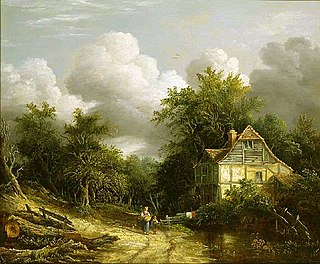
Edward Williams was an English landscape painter during the Victorian era. He had six sons, who were well-known landscape painters as well. Williams is considered the patriarch of the Williams family of painters, which is also referred to as the Barnes School.

Sidney Richard Percy was an English landscape painter during the Victorian era, and a member of the Williams family of painters.
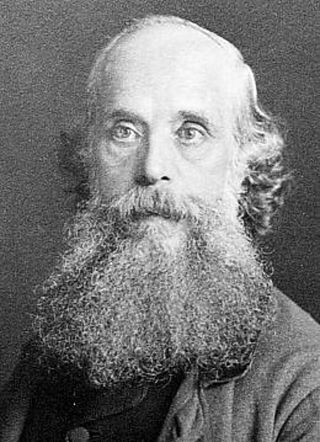
Alfred Walter Williams was an English landscape painter during the Victorian era, and a member of the Williams family of painters.
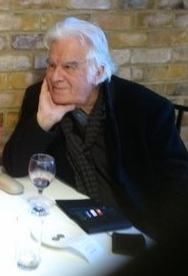
Reginald Gray was an Irish portrait artist. He studied at The National College of Art (1953) and then moved to London, becoming part of the School of London led by Francis Bacon, Lucian Freud and Frank Auerbach. In 1960, he painted a portrait of Bacon which is in the collection of the National Portrait Gallery in London. He subsequently painted portraits from life of writers, musicians and artists such as Samuel Beckett, Harold Pinter, Brendan Behan, Garech Browne, Derry O'Sullivan, Alfred Schnittke, Ted Hughes, Rupert Everett and Yves Saint Laurent. In 1993 Gray had a retrospective exhibition at UNESCO Paris and in 2006, his portrait "The White Blouse" won the Sandro Botticelli Prize in Florence, Italy.
Helen Francesca Mary Binyon was a British artist and writer. She was also a watercolour painter, an illustrator and a puppeteer.
Leonard Beaumont (1891–1986) was an English printmaker, graphic designer, illustrator and publisher. He was one of the earliest exponents of the new art of linocut printmaking in Britain during the early 1930s. He was one of a small group of progressive and highly regarded printmakers who exhibited at the Redfern and Ward Galleries in central London. Whilst working in relative isolation in Yorkshire, most of his contemporaries were linked in some way to the Grosvenor School of Modern Art, located in Pimlico, London.
The International Society of Sculptors, Painters and Gravers was a union of professional artists that existed from 1898 to 1925, "To promote the study, practice, and knowledge of sculpture, painting, etching, lithographing, engraving, and kindred arts in England or elsewhere...". It came to be known simply as The International. The society organised exhibitions, some for members only and some open to others, and social events such as musical evenings and soirées. The exhibitions were held in a number of London venues, and in other cities around England, including Nottingham and Manchester. Its founder and first president was James McNeill Whistler. On his death, the presidency was taken up by Auguste Rodin, with John Lavery as vice-president. The society contributed £500 towards the cost of Whistler's memorial.
John Rutherford Armstrong was a British artist and muralist who also designed for film and theatre productions. He is most notable for the Surrealist paintings he produced.
Mildred Elsie Eldridge known as Elsi Eldridge, was a British artist, mural painter and book illustrator.

Jessica Rosemary Shepherd FLS is a painter, artist, publisher and botanist who works under the names of Úrsula Romero and Inky Leaves.
The Chenil Gallery was a British art gallery and sometime-music studio in Chelsea, London between 1905 and 1927, and later the location of various businesses referencing this early use.

Hilda Annetta Walker FRSA was an English sculptor, and a painter of landscapes, seascapes and horses, flourishing between 1902 and 1958. She was a war artist painting in England during the First and Second World Wars, and described as "escapist". Some of her early work was the production of oilette postcard paintings for Raphael Tuck & Sons, of firemen and horses. She was born in Mirfield, Yorkshire, England, to a family of blanket manufacturers who had the means to foster her art education. She grew up in the Protestant work ethic of Congregationalism, and attended Leeds College of Art, where she studied under William Gilbert Foster of the Staithes group and William Charles Holland King, sculptor of Dover Marine War Memorial. She signed her works "Hilda Walker" or sometimes "Hilda A. Walker".













